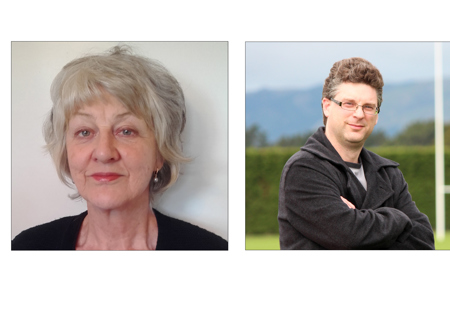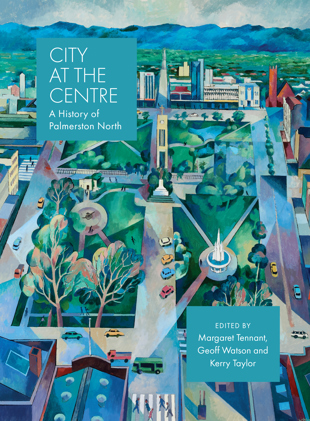Q1: Why Palmerston North? What prompted you to see this book in print?
GW: It has been nearly 50 years since Petersen’s centennial history of Palmerston North and nearly twenty years since Ian Matheson’s Council and Community and we felt it was time for an updated history. On a personal level, I grew up in Palmerston North, so there is a desire to understand something of the history of the place in which I lived.
MT: As in many places, there was a need for synthesis across a number of smaller studies, many of them family-based or focusing upon a single school, business or group. There’s also been a considerable growth in urban history internationally, but in New Zealand the four main centres have dominated that space. I felt it was time for a view from the regions, and to see how some of the national themes were played out in a provincial centre.
Q2: Why is it called City at the Centre?
City at the Centre reflects a number of characteristics of Palmerston North. Its central location was a key selling point for its development via its status as a railway hub. Right from its early years, it was frequently referred to as the ‘crossroads of the North Island’. But there is a sense in which it has also been seen as ‘in the centre’ of social and political trends.
Q3: What has most influenced the shaping of the city?
Rangitāne played a very important role in the shaping of the city. Early accounts of Palmerston North make it very clear that the initial European settlers would not have survived without their assistance and manaakitanga. It is also hard to overlook the role of the railway.
Q4: The book is thematic in approach rather than chronological. What was the thinking behind this?
GW: Most previous general histories of Palmerston North had been written largely chronologically, with a heavy focus on the nineteenth and early twentieth centuries. A thematic approach offered us multiple authorial voices and a different kind of lens onto the city’s story. It also gave an opportunity to bring the story closer to the present. That said, there were certainly other themes we could have chosen if space allowed.
MT: I’m particularly looking forward to delving further into idea of a ‘divided city’, because the points of contention and conflict can be especially revealing when subject to historical analysis – not that we have ignored conflict in the chapters as written.
Q5: Is the population of Palmerston North growing? And is there a future for regional centres in New Zealand?
The population is growing: between 2013 and 2018 it increased from 80,000 to 88,000, and the current Long Term Plan has Palmerston North’s population increasing to 108,000 by 2043. I think there is definitely a future for regional New Zealand … a number of people are looking for more affordable and easier living outside the main centres.
Q6: You have both lived in Palmerston North for most of all your life. What do you like about living there?
GW: I came to Palmerston North when I was one year old, after my father got a job at Massey University, and lived here until 1987. I returned to Palmerston North as a postdoctoral fellow in 2000 and have lived here since. I very much enjoy the easiness and affordability of living in Palmerston North. The He Ara Kotahi pathway is a fantastic addition to the city, opening up both sides of the river.
MT: I’m actually a Feilding girl, and when I was growing up, Palmerston North was the ‘big smoke’! But I’ve lived and worked here most of my adult life without, to my shame, being particularly curious about its history beyond the heritage buildings. I’ve come to appreciate more and more the advantages of life in a city that is small enough to be able to move around with relative ease, acquire housing at a reasonable price, and providing a largely unpolluted environment, yet big enough to have a variety of opportunities, ethnicities and cultural activities to satisfy
Q7: As with many provincial cities, Palmerston North is often dismissed as ‘boring’, or ‘dull’. Do you have a theory as to why the smaller centres are seen in this way?
We certainly had to address a perception in some quarters that Palmerston North (like Hamilton) is – or was – ‘boring’. New Zealand’s provincial cities generally have suffered from the condescension of their larger and older counterparts, and from some lazy stereotyping. As we note in the book, New Zealanders love their sea and beaches and lakes, and places without them don’t do well in the comparison, at least in the eyes of those with a short-term acquaintance. Internationally there’s now a trend to see small cities as having attributes that large cities have lost, and with environmental concerns in an uncertain world, largeness and growth aren’t necessarily virtues. Palmerstonians are no longer apologetic about their city, or about it being an easy place to live in – they are grateful for its ‘livability’!
Q8: Did you discover anything surprising or that you didn’t know about the city?
GW: The chapter ‘Tangata Whenua’ really brings home the fact that the history of Palmerston North extends far beyond European settlement. In particular, Rangitāne have always exercised a presence and influence in the area.
MT: I was struck by the strength of Palmerston North’s reputation as a positive and progressive place for much of its history, and its varied economy, which at different times sheltered it from the worst effects of economic downturn. And I hadn’t appreciated just how significant, and above national averages, its human services sector has been compared with national averages.
Q9: How important is Massey University in the development of the city?
GW: Very important. The decision to locate Massey in Palmerston North signalled its emergence as a place of national significance in New Zealand’s primary industry. Later, when Massey became a university, it significantly boosted the population of Palmerston North and had a flow-on effect on the ethnic diversity, cultural and sporting life, and economy of the city.
MT: And we mustn’t overlook the DSIR/Crown Research Institutes and the Palmerston North Teachers’ College, which was the first to open outside the four main centres. Collectively they made an important contribution to the city’s economy and to its social and cultural life.
Q10: What is your next project?
GW: I think there is much more to be said on the role of Agricultural and Pastoral Organisations in community development, and we are fortunate to have the records of the Manawatu and West Coast Agricultural and Pastoral Society in our local archives.
MT: The public library’s heritage staff jokingly refer to me as a ‘born again’ local historian, and I certainly see heaps of potential for new research drawing upon the local to illustrate wider New Zealand themes. As someone who has worked on welfare history and the history of women in the past I’d like at some stage to apply my familiar lenses to these aspects of Palmerston North’s history. But there’s also space for a social history of the railway from a city perspective. Not so much about the various locomotives and suchlike, but about the use of space – before, during and after the railway went through the city centre – about soot and fires and crossing accidents, about the impact on housing and the streets surrounding the railway, about the movement of people and animals and things, and about workplaces. If anyone had told me I’d get fascinated about the human side of shunting operations, I would have rolled my eyes, but a small piece I did based on a 1925 accident in the Palmerston North shunting yards opened my eyes to the rich industrial relations and workplace hierarchies at a complex railway junction. There’s a very human story behind railways.


